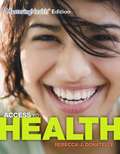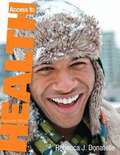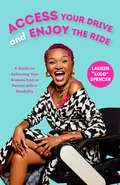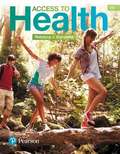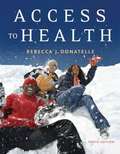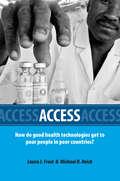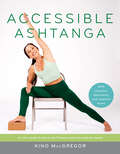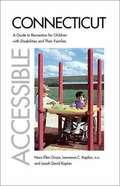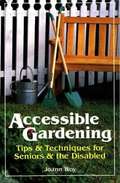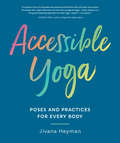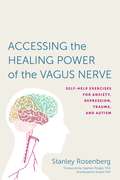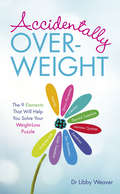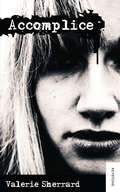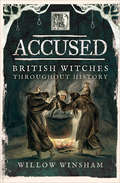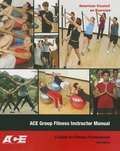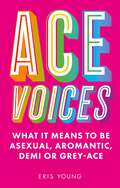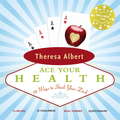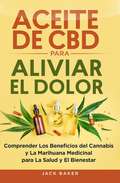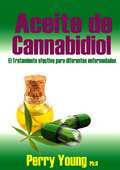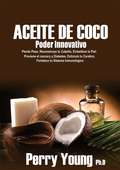- Table View
- List View
Access To Health (Fourteenth Edition)
by Rebecca J. Donatelle Patricia KetchamFor personal health courses. Motivating students to make healthy choices. Long known for its currency, research, and strength in behavior change, Access to Health provides key information through a consistent framework for motivating students to make healthy life choices. As a teacher, mentor, and researcher, Rebecca J. Donatelle knows the issues that are important to today's students. Through her friendly writing style, she addresses students' concerns and teaches them to be savvy and critical consumers of health information.
Access To Health (Thirteenth Edition)
by Rebecca J. Donatelle Patricia KetchamAccess to Health combines research and the most up-to-date information to encourage healthy life choices. As a teacher, mentor, and researcher, author Rebecca J. Donatelle uses her friendly writing style to address readers’ concerns and motivate them to be savvy, critical consumers of health information. The 15th Edition provides readers with new Which Path Would You Take activities that explore various health choices through an engaging, interactive, low-stakes, and anonymous experience, a new full chapter on sleep, and a new Making Change Today feature. All enhancements help readers to make health choices for a better tomorrow.
Access Your Drive and Enjoy the Ride: A Guide on Achieving Your Dreams from a Person with a Disability
by Lauren "Lolo" SpencerTools for People with Disabilities from a Person with a Disability"Access Your Drive and Enjoy the Ride is fun, practical, and no-nonsense."—Stephanie Thomas, TEDx Speaker and founder, stylist, and editor-in-chief of the disability fashion lifestyle website, CUR8ABLE#1 New Release in Physically Disabled EducationLauren “Lolo'' Spencer provides a candid and real inside look into the life of being a person with a disability. This disability advocate embarks on the importance of visibility for the disabled community because representation matters!Words from someone doing the work. Lolo Spencer gained popularity as a YouTube personality. On her platform, Sitting Pretty, she encourages viewers to achieve their dreams through making strong choices. Lolo shares how she navigates daily life with Amyotrophic Lateral Sclerosis (ALS). You are more than your limits. Choosing to see herself as more than a person with a disability and wheelchair user, Lolo chooses to live a bold and courageous life now because representation matters. She created this intersectional guide to provide tools for people with disabilities to thrive in personal growth, independence, and community building. Add this guide to your list of inclusion books!Inside, you’ll find:An intersectional guide on how to grow personally and professionallyTools for people with disabilities to live a full life despite limitations and expectationsWords from the inspiring Lauren “Lolo” Spencer, your favorite disability advocateIf you're looking for gifts for people with disabilities to get encouraged like Disability Visibility, Demystifying Disability, or Rolling Warrior, you’ll love Access Your Drive and Enjoy the Ride.
Access to Health
by Rebecca DonatelleAccess to Health combines research and the most up-to-date information to encourage healthy life choices. As a teacher, mentor, and researcher, author Rebecca J. Donatelle uses her friendly writing style to address readers’ concerns and motivate them to be savvy, critical consumers of health information. The 15th Edition provides readers with new Which Path Would You Take activities that explore various health choices through an engaging, interactive, low-stakes, and anonymous experience, a new full chapter on sleep, and a new Making Change Today feature. All enhancements help readers to make health choices for a better tomorrow.
Access to Health (10th edition)
by Rebecca J. DonatelleDonatelle (public health, Oregon State University) challenges undergraduate students to think globally as they consider health risks and personal health decisions. New opportunities for self-assessment and behavior change are offered in this edition, in the form of behavior change contracts and boxes on tattoos, safer sex, and club drugs. There is expanded information on the mind-body connection and alternative medicine, as well as new coverage of contraceptive devices and weight management. Annotation (c)2003 Book News, Inc., Portland, OR (booknews.com)
Access to Information: Materials, Technologies, and Services for Print Impaired readers
by Tom Mcnulty Dawn SuvinoThis is a book about alternative media for people with print disabilities
Access to Mass Transit for Blind and Visually Impaired Travelers
by William R. Wiener Mark M. Uslan Alec F. Peck Arlene SternAccess to Mass Transit addresses travel issues vital to independence for blind and visually impaired persons from several perspectives- those of blind and visually impaired persons who use mass transit, orientation and mobility instructors, and transportation professionals. Focusing on national and international issues, this information-filled manual covers approaches to making mass transit accessible in several cities in the United States and in Canada, the United Kingdom, and Japan. Arranged in a well-illustrated, easy-to-use format, tips, techniques, guidelines, and adaptive strategies are presented for safe and independent travel on subways, buses, and commuter rails.
Access to Medicines as a Human Right
by Jillian Clare Kohler Lisa FormanAccording to the World Health Organization, one-third of the global population lacks access to essential medicines. Should pharmaceutical companies be ethically or legally responsible for providing affordable medicines for these people, even though they live outside of profitable markets? Can the private sector be held accountable for protecting human beings' right to health?This thought-provoking interdisciplinary collection grapples with corporate responsibility for the provision of medicines in low- and middle-income countries. The book begins with an examination of human rights, norms, and ethics in relation to the private sector, moving to consider the tensions between pharmaceutical companies' social and business duties. Broad examinations of global conditions are complemented by case studies illustrating different approaches for addressing corporate conduct. Access to Medicines as a Human Right identifies innovative solutions applicable in both global and domestic forums, making it a valuable resource for the vast field of scholars, legal practitioners, and policymakers who must confront this challenging issue.
Access: How Do Good Health Technologies Get to Poor People in Poor Countries?
by Michael Reich Laura J. FrostMany people in developing countries lack access to health technologies, even basic ones. Why do these problems in access persist? What can be done to improve access to good health technologies, especially for poor people in poor countries?This book answers those questions by developing a comprehensive analytical framework for access and examining six case studies to explain why some health technologies achieved more access than others. The technologies include praziquantel (for the treatment of schistosomiasis), hepatitis B vaccine, malaria rapid diagnostic tests, vaccine vial monitors for temperature exposure, the Norplant implant contraceptive, and female condoms. Based on research studies commissioned by the Bill & Melinda Gates Foundation to better understand the development, adoption, and uptake of health technologies in poor countries, the book concludes with specific lessons on strategies to improve access. These lessons will be of keen interest to students of health and development, public health professionals, and health technology developers--all who seek to improve access to health technologies in poor countries. This edition now includes a new preface by the authors.
Accessible Ashtanga: An All-Levels Guide to the Primary and Intermediate Series
by Kino MacGregorA bold, much-needed guide for Ashtanga yoga practice, useful for all levels and illustrated with 250 color photos, by one of yoga&’s best known and respected teachers, Kino MacGregor. This offers an updated, more accessible view of the traditional series, adapting it to serve a wider range of practitioners.Even experienced practitioners find the challenging style of Ashtanga Yoga to be daunting. Whether you&’re a beginner, living in an unconventional yoga body, or need modifications for any reason, this book will make you feel empowered, inspired, and confident to make the adjustments and modifications that feel right for your body. Kino posits that the Ashtanga Yoga method needs a systemwide reset and reevaluation to make it viable and beneficial to all students. She reframes the guru model and re-envisions the method in a way that will truly make Ashtanga available to all, while maintaining the integrity of the traditional teachings.She also presents a brief theory of movement mechanics that can help prevent injury, optimize physical mobility, and tap into the natural intelligence of the body. The practice section presents each of the poses of the Ashtanga Yoga Primary Series—plus some of the poses in the Ashtanga Yoga Second Series—in traditional, modified, accessible, and adaptive forms (including using blocks and a chair). Not only will you see how to modify the pose, you will learn how best to work the pose for your unique need. Teachers will find plenty of reference material to update their teaching methodology.
Accessible Connecticut: A Guide to Recreation for Children with Disabilities and Their Families
by Nora Ellen Groce Lawrence C. Kaplan Josiah David KaplanThis user-friendly guide helps parents of children with disabilities plan family outings in Connecticut that are stimulating and fun. Intended for youngsters who use wheelchairs or who have visual, hearing, or mental impairments, it presents places throughout the state that are easily accessible and reasonably priced and that require little or no prior planning. The entries are arranged by type of activity. They include places to see animals (zoos, aquariums, hatcheries, farms); children's museums; museums of nature, history, science, fine arts, and special interest; places of historic interest; playgrounds; nature centers and walks; theaters and performing arts; and weekend excursions for the family. Each place or activity lists location, directions, phone numbers, web information, hours, admission fees, brief descriptions, and assessment of accessibility by type of disability. The guide is an invaluable resource, helping children with disabilities (or, for that matter, parents with disabilities) share with their families the experiences and playtime activities that are part of all happy childhood memories. Book jacket.
Accessible Gardening: Tips And Techniques For Seniors And The Disabled
by Joann WoyIf advancing age, illness, or accident has made gardening too difficult for you, don't become frustrated. There is an alternative. Accessible Gardening is a book of tips and techniques that will help you to overcome obstacles and return the joy of gardening to your life: recommendations for modifying an existing garden for gardening ease; advice on selecting ergonomic tools and low-maintenance plants; directions for constructing raised-bed planters; instructions for developing manageable watering and pest-control systems; specifications for paths, inclines, and railings; discussion on the psychological and physical benefits of gardening.
Accessible Yoga: Poses and Practices for Every Body
by Jivana HeymanThis daring, visionary book revolutionizes yoga practice--and makes it truly accessible to everyone, in every body, at any age, and in any state of health.Yoga practice has so much to offer us physically, emotionally, mentally, and spiritually. But many of us feel discouraged to practice because we see young, slim, flexible, well, and able-bodied people dominating yoga spaces. Yet, yoga is truly a practice for all--conferring enormous benefits to our overall well-being as our bodies change, age, and navigate various health challenges. Jivana Heyman, founder of Accessible Yoga, views yoga as a basic human right--saying we all deserve to practice it in whatever state we find our body or mind. Accessible Yoga offers a simple, clear, and wonderfully adaptable practice for all people regardless of ability, health, and body type. Heyman has spent over twenty years sharing yoga with people of all abilities and backgrounds, and in this book, he shares his knowledge by breaking down complex yoga poses, breathing practices, meditation techniques, and yoga teachings into clearly understandable and practical tools we can use every day, regardless of our limitations or challenges.
Accessing the Healing Power of the Vagus Nerve: Self-Help Exercises for Anxiety, Depression, Trauma, and Autism
by Benjamin Shield Stephen W. Porges Stanley RosenberyThis practical guide to understanding the cranial nerves as the key to our psychological and physical well-being builds on Stephen Porges’s Polyvagal Theory—one of the most important recent developments in human neurobiology. Drawing on more than thirty years of experience as a craniosacral therapist and Rolfer, Stanley Rosenberg explores the crucial role that the vagus nerve plays in determining our psychological and emotional states and explains that a myriad of common psychological and physical symptoms—from anxiety and depression to migraines and back pain—indicates a lack of proper functioning in the vagus nerve. Through a series of easy self-help exercises, the book illustrates the simple ways we can regulate the vagus nerve in order to initiate deep relaxation, improve sleep, and recover from injury and trauma. Additionally, by exploring the link between a well-regulated vagus nerve and social functioning, Rosenberg’s findings and methods offer new hope that by improving social behavior it is possible to alleviate some of the symptoms at the core of many cases of autism spectrum disorders. Useful for psychotherapists, doctors, bodyworkers, and caregivers, as well as anyone who experiences the symptoms of chronic stress and depression, this book shows how we can optimize autonomic functioning in ourselves and others, and bring the body into the state of safety that activates its innate capacity to heal.
Accidentally Overweight: The 9 Elements That Will Help You Solve Your Weight-Loss Puzzle
by Dr Libby Weaver"What leads the human body to get the message that it needs to store fat and what leads the human body to get the message that it needs to burn fat?" In a dynamic, fresh approach to weight loss, acclaimed nutritional biochemist Dr Libby Weaver discusses the nine factors that cause us to either lose or gain weight. These factors include: calories, stress hormones, sex hormones, liver function, thyroid function, gut bacteria, insulin, the nervous system and emotions. Let's face it - for many people it is not a lack of education that leads them to polish off a packet of chocolate biscuits after dinner, but their biochemistry and emotions.Accidentally Overweight explores the role of these two factors in fat storage and optimal wellness.Accidentally Overweight was born out of the 14 years Dr Libby spent at university, her strong scientific background in both nutrition and dietics and her PhD in biochemistry. Libby has thousands of stories about how, what she calls the 'calorie equation' (how much you eat versus how much you move) is not the only determinant of our body shape and size. At the end of the day, if it was truly as simple as the calorie equation, everyone would be trim, taut and terrific and there'd be no health consequences because of excess body weight. This is not just another diet book - it is a life-changing way of understanding your body and health.
Accomplice
by Valerie SherrardShort-listed for the 2012 SYRCA Snow Willow Award Lexie Malton is an average Vancouver teen with fairly typical issues. Her stepmother is far from her favourite person, she has a sister with special needs, and life outside the home is the usual mix of school, friends, and social events. But Lexie has a secret. Her ex-boyfriend, Devlin Mather, is now a heroin addict living on the street, and only Lexie knows that shes the one who put him there. Guilt makes her give in to Devlins demands for money time and time again, even though she knows how dangerous his drug use is. Lexie finally gathers the strength to stop enabling Devlin. But when he seeks treatment for his addiction, Lexie finds herself drawn back to him, never guessing what a dark and deadly path she has just chosen. Devlin relapses, and his desperation leads to an act that will change both of their lives forever.
Accused: British Witches throughout History
by Willow WinshamThe true stories of eleven notorious women, across five centuries, who were feared, victimized, and condemned for witchcraft in the British Isles. Beginning with the late Middle Ages—from Ireland to Hampshire—hundreds of women were accused of spellcasting, wicked seduction, murder, and consorting with the devil. Most were fated for the gallows or the stake. What did it mean for these prisoners to stand accused? What were they really guilty of? And by whom were they persecuted? Drawing on a wealth of primary sources including trial documents, church and census records, and the original sensationalist pamphlets describing the crimes, historian Willow Winsham finds the startling answers to these questions. In the process, she resurrects the lives, deaths, and mysteries of eleven women subjected to history&’s most notable witch trials. From Irish &“sorceress&” Alice Kyteler who, in 1324 was the first accused witch on record, to Scottish psychic Helen Duncan who, in 1944, was the last woman imprisoned under Britain&’s Witchcraft Act of 1735. Dames, servant girls, aggrieved neighbors, suspect widows, cat ladies, prostitutes, mothers, wives, daughters, and sisters. Accused brings all these victims, and the eras in which they lived and died, back to life in &“an incredibly well researched . . . stunning and admirable piece of work, highly recommended&” (Terry Tyler, author of the Project Renova series).
Ace Group Fitness Instructor Manual: A Guide for Fitness Professional
by AceThe all-new ACE Group Fitness Instructor Manual, 3rd Edition, prepares fitness professionals to design effective group fitness programs and both safely and successfully lead a wide range of class formats and participants. A must-have resource for group fitness instructors, the manual addresses critical core competencies regardless of the types of classes you plan to teach. Topics range from instruction techniques and program design to the business of group fitness and an instructor's ethical and legal responsibilities as well. Additionally, the manual tackles important considerations that group fitness instructors face when instructing a variety of individuals, including pregnant women and those with significant weight challenges. The manual includes an all-new companion DVD, Essentials of Group Fitness Instruction, on which world-renowned group fitness expert and award-winning presenter, Lawrence Biscontini, offers essential steps and strategies to unlocking the critical elements of group fitness. Discover key components of class design, such as how to determine desired outcomes through exercise and movement selection, sequencing, choreography, program modifications and music.
Ace Health Coach Manual: The Ultimate Guide To Wellness, Fitness, And Lifestyle Change
by Cedric X. Bryant FACSM Daniel J. Green Sabrena MerrillHealth Coach Manual: The Ultimate Guide To Wellness, Fitness, And Lifestyle Change
Ace Voices: What it Means to Be Asexual, Aromantic, Demi or Grey-Ace
by Eris YoungHow do we experience attraction?What does love mean to us?When did you realise you were ace?This is the ace community in their own words. Drawing upon interviews with a wide range of people across the asexual spectrum, Eris Young is here to take you on an empowering, enriching journey through the rich multitudes of asexual life. With chapters spanning everything from dating, relationships and sex, to mental and emotional health, family, community and joy, the inspirational stories and personal experiences within these pages speak to aces living and loving in unique ways. Find support amongst the diverse narratives of aces sex-repulsed and sex-favourable, alongside voices exploring what it means to be black and ace, to be queer and ace, or ace and multi-partnered - and use it as a springboard for your own ace growth. Do you see a story like your own?
Ace Your Health
by Theresa AlbertWith our fast-paced lives, it is no wonder more than 50% of North Americans are overweight or obese, and there are record numbers of diabetes, heart attacks, strokes, and cancer. It is time to find a better way to live. Ace Your Health takes a huge topic and boils it down to simple, small shifts that you can easily integrate into your daily routine. The clever concept uses the fact that there are 52 weeks in the year and 52 cards in a deck. This book helps you "play your cards right" by making one simple play per week, and walks you through a year towards improved overall health.Each "card" lays out a concise, accessible explanation of why you want to make this shift and what background information you need to know. Then, it follows up with a real life assignment on how to apply this new knowledge and ends with a dead easy, crazy tasty recipe. While the spades, hearts, and clubs sections focus on food and eating habits, in the diamonds section you will find advice on sleeping better, reducing stress and anxiety, stretching, and many other aspects that will help round out a new healthier (and happier) lifestyle. You will never again be gambling with your own life once you Ace Your Health.From the Trade Paperback edition.
Aceite de CBD para aliviar el dolor: Comprender los beneficios del cannabis y la marihuana medicinal para la salud y el bienestar
by Jack Baker¿Desea tratar el dolor de forma segura, aliviar el estrés y conocer la ciencia que hay detrás del CBD? ¿Le cuesta entender la diferencia entre el CBD y el THC? ¿Sufre de dolores corporales y busca formas naturales de tratar sus dolencias sin usar medicamentos recetados? ¿Siente curiosidad por saber qué es el CBD y se pregunta cómo puede ayudarle en su día a día? ¿Busca una guía de recursos que le ayude a entender cómo aliviar el dolor de forma segura y natural? Si esto le suena familiar, ¡siga leyendo! El CBD, también conocido como aceite de cannabidiol, es el nuevo producto de moda para tratar dolencias. Tras la legalización de la marihuana medicinal, ahora puedes añadir este aceite a diversas recetas, utilizarlo en zonas de dolor e incluso añadirlo a tus productos para el cuidado de la piel. Utilizar el CBD le ayudará a tratar muchas dolencias comunes, sin importar lo grandes o pequeñas que sean. Independientemente de quién seas y de lo que quieras conseguir, lo básico del CBD es lo mismo para todos. Este libro le ayudará a entender todo lo que necesita saber sobre el CBD, incluyendo los beneficios y los retos que conlleva, y le proporcionaré un proceso paso a paso para lograr un mayor nivel de bienestar junto con algunos consejos y recetas prácticas que puede utilizar para reforzarlo. Nunca antes ha habido un libro tan suave en su enfoque y tan eficaz y que ayude a la gente a cambiar su vida para mejor. Dentro de estas páginas, descubrirá: • ¿Qué es el CBD? • Tipos de CBD • ¿Cómo funciona este aceite para el dolor? • ¿Quién debe usar el Aceite de CBD y quién debe evitarlo? • Varias dolencias que pueden tratarse con CBD • Dosificación del aceite de CBD • Tratamiento del dolor crónico con aceite de CBD • Efectos secundarios comunes • Más de 42 recetas con aceite de CBD • Té
Aceite de Cannabidiol (CBD) El tratamiento efectivo para diferentes enfermedades
by Perry Young Alfredo JiménezAPRENDA COMO REDUCIR EL DOLOR, SANAR MAS RAPIDO, VIVIR MAS SALUDABLE Y FELIZ. TODO ESTO SE PUEDE LOGRAR CON EL ACEITE DE CANNABIDIOL. ¿ Puede el aceite de cannabidiol (CBD) ayudarme con el dolor ? ¿ Puede el aceite de cannabidiol (CBD) ayudarme con el estres y la ansiedad ? ¿ Puede el aceite de cannabidiol (CBD) ayudarme con mi depresión ? ¿ Puede el aceite de cannabidiol (CBD) ayudarme con el Parkinson? ¿ Puede el aceite de cannabidiol (CBD) ayudarme con la diabetes? ¿ Puede el aceite de cannabidiol (CBD) ayudarme con el asma? ¿ Puede el aceite de cannabidiol (CBD) ayudarme con el glaucoma? ¿ Puede el aceite de cannabidiol (CBD) ayudarme con la adicción al cigarrillo? Si andas buscando las respuestas a esas preguntas, bienvenido pues has llegado al final de tu busqueda. En este libro conseguiras todas esas respuestas y algunas más. También aprenderas los siguientes beneficios del uso del aceite de cannabidiol Mejora del dolor Optimiza el sistema inmunológico Fortalecera tu corazón Aumenta la memoria Controlar tu apetito y tu peso Limpiar la piel... ... Y muchas otras cosas más.... ... Si deseas aprender mas de los increibles usos medicinales del aceite de CBD e inclusive como prepararlo tu mismo.... ... Es muy fácil, has click en el botón de comprar, recibe el libro, disfruta la lectura, y aprovecha los beneficios que obtendras con el uso del aceite de CBD en tu vida.
Aceite de Coco Poder Innovativo: Pierde Peso, Reconstruye Tu Cabello, Embellece La Piel, Previene El Cáncer Y Diabetes, Estimula Tu Cerebro, Fortalece Tu Sistema Inmunológico
by Perry YoungEL ÚNICO LIBRO QUE NECESITA PARA PERDER PESO MÁS RÁPIDO, MAXIMIZAR SU SALUD, EMBELLECER SU PIEL Y RECONSTRUIR SU CABELLO Mientras los años pasan, solemos pensar si existe algo que podamos hacer para que las cosas sean igual que antes Lo principal es nuestra cintura. En ese punto, la piel empieza a resecarse, agrietarse y arrugarse, con menos flexibilidad. A largo plazo, hasta el cabello se vuelve fino, seco, apagado y muerto Echando un vistazo en el espejo cada mañana resulta ser enloquecedor, en especial cuando comparamos en lo que nos hemos convertido con lo que solíamos ser En ese punto la memoria empieza a descuidarse, empezamos a pasar por alto los aparentes detalles insignificantes diarios. Hubo un periodo donde nuestra memoria era muy perspicaz, sin embargo, ahora hacemos chistes sobre esas cosas que hemos pasado por alto Bromeamos para mitigar el tormento de envejecer y entender que un día, no tendremos la capacidad de recordar a los individuos vitales en nuestras vidas La edad, al parecer, nos abandonará a cada uno como un escudo de lo que solíamos ser Sé cómo se siente, una vez estuve en una situación similar Por un considerable tiempo, batallé con mi peso y la grasa que no dejaba a mi cuerpo, sin importar cuanto me esforzara en mi alimentación o cuanto ejercicio hiciera para quitarme esas indeseables libras, el peso regresaba Descubrir sobre las ventajas médicas del aceite de coco fue una ventaja distintiva para mí, y podría serlo para usted también En cualquier caso, aun con la mayoría de la información que tenía sobre el asunto, no era capaz de escapar de los efectos colaterales que describí antes Cuando empecé a escuchar sobre las ventajas médicas de este producto natural, me sumergí y empecé la mayoría de la investigación fundamental para ver cómo añadiendo el coco a mi régimen diario podría cambiar mi vida en una forma positiva
Aceite de cáñamo de CBD: Cómo usar el aceite de CBD para dolores por cáncer, ansiedad, fibromialgia y enfermedades crónicas
by Solomon TernderAceite de cáñamo de CBD - Cómo usar el aceite de CBD para dolores por cáncer, ansiedad, fibromialgia y otras enfermedades crónicas ha sido escrito por la pasión de ayudar a que aprenda los maravillosos beneficios que proporciona el aceite de cannabis a la salud Mi mayor deseo es aclarar la confusión acerca del aceite de cáñamo de CBD y proporcionar respuestas bien documentadas sobre las preguntas más frecuentes y más desconcertantes acerca del aceite de cáñamo de CBD, tales como: ¿Hay diferencia entre el aceite de CBD y el aceite de cáñamo? ¿Estaré drogado si consumo aceite de CBD? ¿Cuánto tiempo se mantiene el CBD en la sangre? ¿Puede dosificar excesivamente el CBD? ¿El aceite de CBD es legal en los 50 estados? ¿El aceite de CBD dará positivo en un análisis de drogas? ¿El aceite de CBD me ayudará a dormir? ¿El aceite de CBD puede ayudar contra el EPOC? ¿El aceite de CBD ayuda contra el reumatismo? y muchas otras preguntas. En "Aceite de cáñamo de CBD - Cómo usar el aceite de CBD para dolores por cáncer, ansiedad, fibromialgia y otras enfermedades crónicas ", Podrá: Descubrir cómo consumir aceite de cáñamo de CBD para epilepsia, fibromialgia, etc. Comprender el mejor momento y dosis para el aceite de cáñamo de CBD que garantiza resultados. Aprenda de otros usuarios contentos de aceite de cáñamo de CBD que han sido ayudados de varias maneras y han compartido sus testimonios. Lea las maravillosas historias de éxito de algunas de las personas felices como Tim que han informado que el cannabidiol del aceite de CBD "¡Eliminó mi dolor de espalda que sufrí por 30 años!" y Jeff quien comparte cómo el aceite de cáñamo de CBD "Detuvo el dolor crónico de cadera y articulaciones y le permitió dormir toda la noche. Camino sin dolor, puedo pararme sin bastón y pude bailar por primera vez en dos años" Aprenderá cómo usar el aceite de cáñamo de C
